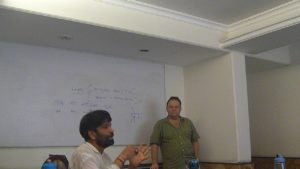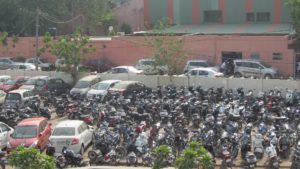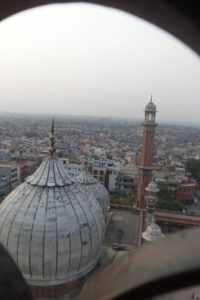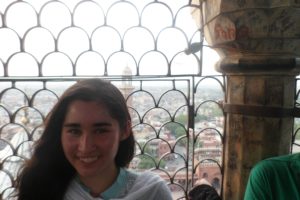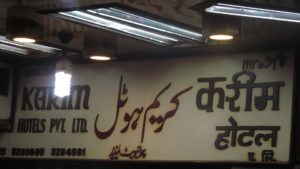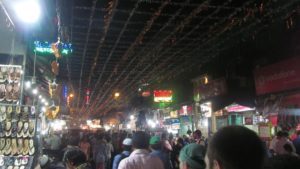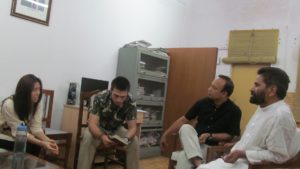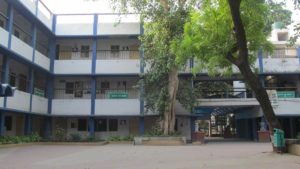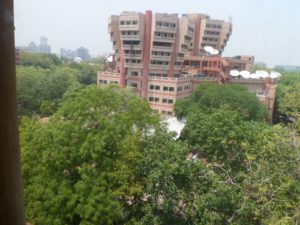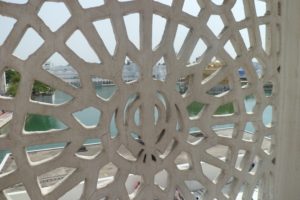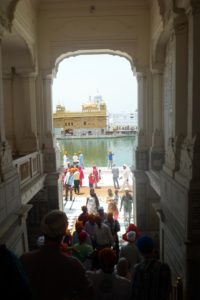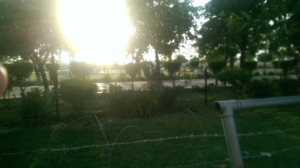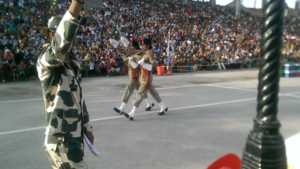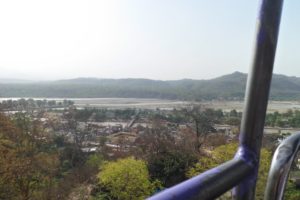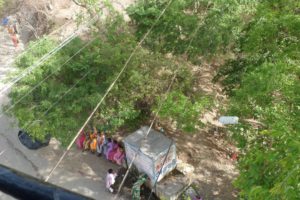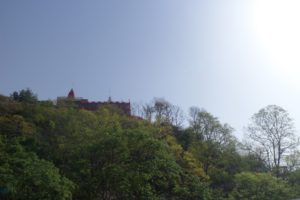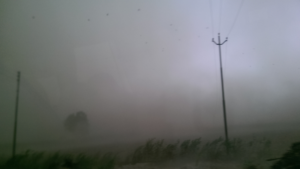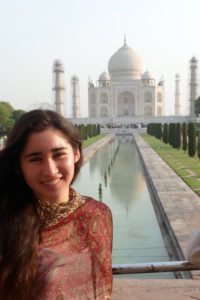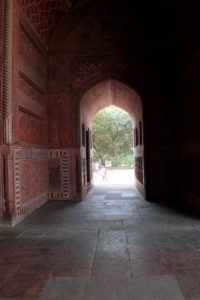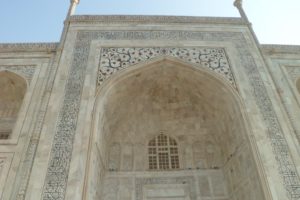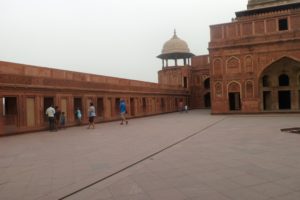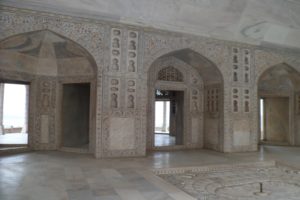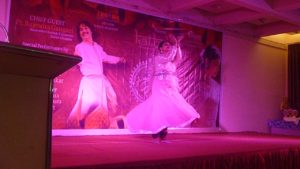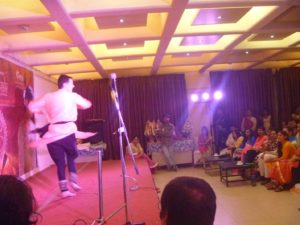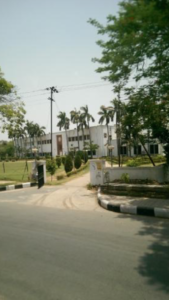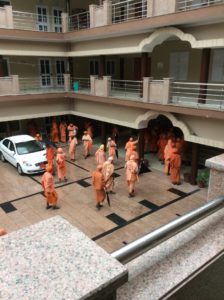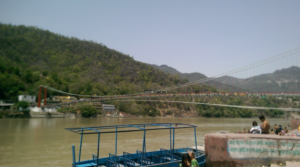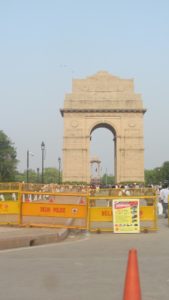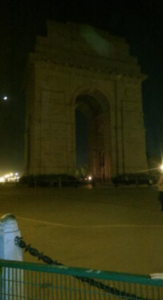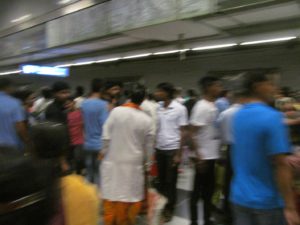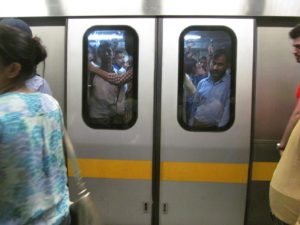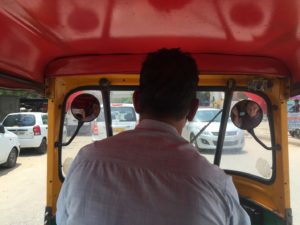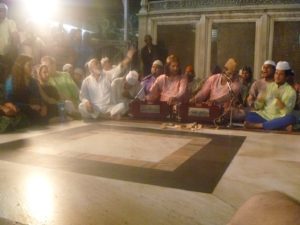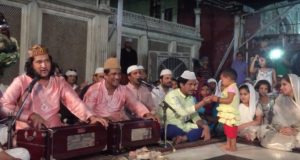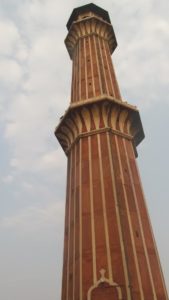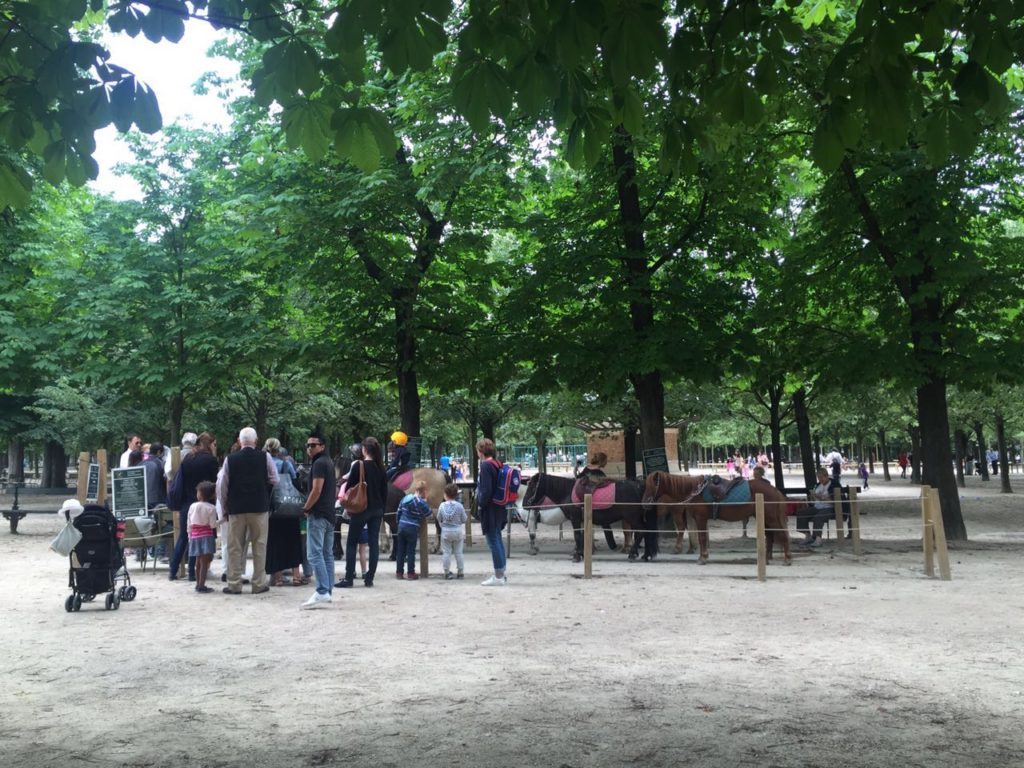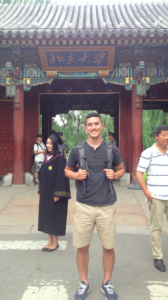We spent our last week in the southern city of Hyderabad. We took a flight there from New Delhi and stayed in the center of the old part of the city. Much of the week was spent in finals, writing papers, doing skits and presentations, and preparing for and taking exams.
(In class)
Nevertheless, we also did get to see some of the city. We visited the Char Minar, an ancient Muslim mosque as well as the surrounding marketplace and city center. We also tried biriyani, which people from all over India encouraged us to try every time we mentioned that we’d be visiting Hyderabad. The dish insists of rice and meat, either mutton or chicken, that is cooked with lots of spices and coved in a savory red oil. During the week we also visited the Golkanda fort, the Shahi tombs, and the production center of India’s biggest Urdu newspaper where met with it’s owner, Siyasat Zahid Ali Khan.
Language tasks:
TASK 2: Identify a current and controversial social topic in the newspaper; select something that is perceived as more of a cultural issue than a purely political one. Next, find three native speakers to interview on this topic. Briefly ask them for their opinions on the topic and explore their rationales. Do not inject your own opinion into the interview and remain objective and respectful even if you do not agree with their statements. Consider how cultural assumptions influenced your perception of events/issues and the responses of your interviewees.
Religion is a very relevant and controversial social topic we see frequently mentioned in the newspaper. Especially since the partition of Pakistan from India, religious tension between groups in India, particularly Hinduism, Islam, and Sikhism, have divided communities, caused violence, and led to divisive politics. One night in Aligarh, near the entrance of Aligarh Muslim University, we met a Muslim congressman who was out to dinner with his family and discussed how religion is playing into Indian politics. He said that all religions seeks harmony and common good, but that fighting is instigated by politicians who want to use sentiment and religious identity to gain votes and stay in power. He also suggested that government officials are corrupt, and that businesses that supply weaponry and supplies in wars have a monetary gain from pitting religions against each other. This struck me in particular because it sounded like the same as the answer I was told in Bosnia studying the cause of the Yugoslavian war. The Yugoslavian war resulted in ethno-religious slaughter and partition into four countries based on ethnic identity, despite the fact that people of all groups remain in each country. The Aligarh politician’s statement led me to the greater question of how people of different identities live together, and how they are driven apart. Visiting Mathras, the birthplace of Krishna, I met a man at the temple and asked him about the historic mosque next-door. He firmly encouraged our group to stay away from there, telling us that “they are bad people”. The Char Minar in Hyderabad is a monument and mosque which is a relic leftover from Muslim rule of the city. The site has become a subject in newspapers because of the establishment of a temple to Lakshmi, a place of Hindu worship at the base of the Char Minar. Many consider this a part of a growing trend of Hindu temples being established at Muslim temples and historic sites. I asked a street vendor about this and instead of getting passionate or angry, he said he trusted in Allah to carry out justice, so he wasn’t going to judge whether the Hindu’s were acting in a way that was right or wrong.
TASK 3:
Islam is a religious minority in India, with Muslims numbering 172 million people or 14.2% of the country’s population. Despite being small in size, Islam has a long history in India and has left a notable mark on the country’s culture in the form of architecture, art, music, and more. Further Muslims carry substantial political power. One of the five pillars of Islam is the hajj or pilgrimage. While the Hajj is carried out year round in Mecca in Saudi Arabia, the 6th-12th days of the 12th month of the Islamic calendar are a special time for preforming the pilgrimage and therefore a significant event in the year for Indian Muslims. The Sikh religion, which was born in 15th century in Punjab and is now split between Pakistan and northern India is founded on religious tolerance. While in Amritsar, a holy site of Sikh worship in Punjab, we saw a painting of the Sikh founder Guru Nanak, which a woman told us depicted him in Mecca seeking to worship with Muslims. Throughout his life, Guru Nanak sought to unite people of different faiths without making them abandon their own religions, and even had a Muslim as his closest friend. Nevertheless, when we brought this up with an official he adamantly denied that the painting depicted Mecca. Our professors told us that the woman’s explanation was what officials had told them in previous years, and suggested that the official’s new response was because he had a prejudice against Guru Nanak being associated with Islam.
TASK 4: Identify two people who are members of a social/ethnic/racial/economic minority in your country of study. Ask them about their minority status and how they feel that they are treated by the majority members of the community. Note cultural attitudes that influence the treatment of minority communities in your country of study and how these attitudes differ from the US.
In India, dalits are the lowest caste, and discrimination against them at ever level of Indian society, from villages to top universities, is frequently reported in both Indian and western media. In particular the millennia old practice of “untouchability” or exclusion of dalits from full participation in society has been highlighted as a major human rights issue in India. Coming into this country as foreigners, my group members and I had a lot of questions about this group which comprises up to 32% of the population of the state of Punjab and 21% of UP or Uttar Pradesh. Throughout our trip, as groups and individuals we approached many dalit workers in our hostels, Indian friends, and people who employed dalits as servants. Overall, we found that people of all castes and economic groups were very reluctant to talk about this and were quick to change the subject. Eventually I encountered the Dean of Jamia Millia Islamia University, who, while not being a dalit, had a lot to say about the rights of Dalits in India and how the university is addressing it. He compared the struggle of Dalits in India to that of African-Americans in the US, and criticized the lack of attention to Dalit discrimination in post-colonial India. He explained the quota system (equivalent to affirmative action) which the government of India has established for all universities in India to ensure representation of all social and ethnic groups. In particular JMI is labeled a “minority character university” by the government, meaning that they represent and uphold the culture of the Muslim minority in India. Keeping this minority character in mind, the university is devoted to and known for having a diverse campus, and heavily recruits dalits from low economic backgrounds.
TASK 6: Interview three people of different ages and genders with whom you are familiar/friendly about their attitudes towards the United States. What is their attitude towards the US in general? Are there specific issues (e.g. foreign policy, government structure, culture, etc) that they especially like/dislike? What are their rationales for these attitudes and opinions? Do not inject your own opinion into the interview and remain objective and respectful even if you do not agree with their statements. Consider how local cultural values influenced the responses of your interviewees as well as your own (internal) reactions to their commentaries.
The first person I talked to was Lali, a Punjabi factory owner in his twenties who had recently gotten engaged. He had a lot to say about the upcoming US election, which I have noticed is being covered thoroughly in media sources throughout India. Lali was quick to denounce Trump and compared him to certain prominent politicians in Indian government right now who use religious power to get elected but who are actually corrupt. In politics in India today, the BJP is the party in power and is often tied to Hindu nationalism. This criticism is especially strong from it’s rival the AAP, or Aam Admi Party, which markets itself as representing the common man. Nevertheless, AAP has also been receiving increased criticism from media for aligning itself with religious leaders. The second person I spoke with was Mr. Uppal, a father living in New Delhi. He sees the western economy as being on the decline, but firmly believes that America’s capitalist structure will keep it as a world power. In India, we have encountered many people with a notable work ethic, from shopkeepers to wealthy businessmen. Speaking from his own experience, Mr. Uppal argued that the work ethic fostered by the capitalist structure which made the US so successful is what is fueling the current rapid growth of India’s economy. The third person I spoke with was a woman named Mrs. Kumar on the train from Punjab to Delhi who works in media and has a son in school in the US. She compared India and the US, noting that India is family oriented and pluralistic while America is more individualistic and isolated. She also mentioned that since going to the US her son has picked up more “western” habits, like calling her less, and she said that this is the mark of globalization.
